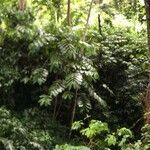Trees 5-10 m. tall, the young branches densely hirsute with spreading (less frequently appressed) golden hairs, eventually glabrate. Leaves oblong-obovate, more or less cordate and usually not strongly inequilateral at the base, subcuspidate-acuminate at the tip, 20-30 cm. long, 10-14 cm. broad, membranaceous, minutely and closely ciliate-denticulate, both surfaces golden spreading-hirsute but par-ticularly beneath, the petioles about 1 cm. long; stipules 3-6 cm. long. Inflores-cences in clusters of 2-4 in catenate series of the upper leaf-axils, occasionally solitary. Staminate heads conduplicate-reniform, about 1.5 cm. long and 2 cm. broad, the peduncle about 1 cm. long. Fruiting heads thickly discoid, 4-5 cm. in diameter, about 1.5 cm. thick, sessile or subsessile, the component flowers half or more coherent, developing an orange or reddish pulp at maturity.
A tree. It grows 30 m tall. It loses its leaves during the year. The leaves are 45 cm long by 17 cm wide. The leaves have tufts of hair along the edge. The leaves are hairy underneath. The flowers are green or yellow. They are in flattened head like clusters. The fruit is a flat disk of green bracts. These have about 20-30 orange-red fleshy 1 seeded fruit. The seeds are 8-10 mm long by 6-8 mm wide.
Pending. See Cooper & Cooper (2004: 321), and Zich et al., Castilla elastica, in Australian Tropical Rainforest Plants Edn 8 (2020).





